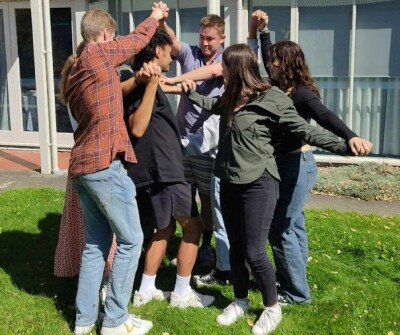New area model provides practical benefits


Positive changes and new ways of working are helping the New Zealand Red Cross have more impact thanks to our new area model that has been operating since 1 July.
-
These changes include fostering strengthened relationships, better connections, and stronger representation for youth councillors.
-
The new area model is part of our journey towards Realising 2030, the implementation of our Strategy 2030, which will work to create a New Zealand Red Cross that is a people-centric, diverse, and sustainable organisation.
-
By 2030 we aim to have a supported membership and volunteer base that represents the diversity of New Zealand and helps improve the lives of vulnerable people by mobilising the power of humanity and enhancing community resilience.
Simplified governance improves knowledge sharing

Strong bonds formed between Area 7 team members during their tour through Otago and Southland in May. Pictured in Gore from left to right: Phoebe Neo (Area Support Advisor), Daniele Graunke Gemelli (Administrator), Callum Clark (Senior Area Partner) and Steve King (Area Coordination and Planning Lead).
Reducing the number of area councils from 15 to seven has simplified our governance processes. This allows us to provide services in a coordinated and efficient way while growing and supporting our members, including those who volunteer their time.
Combining areas has already provided Area 7 (Otago and Southland) with improved knowledge sharing and learning following the merger.
Callum Clark, Senior Area Partner for Area 7, says clear benefits have resulted from the new area model.
“For me personally, it was great to get an insight into how the former Otago Area Council and branches operate and see all the good things they do, while being able to share from the Southland perspective, so we could learn from each other and incorporate the best practices into the greater Otago-Southland Area.”
Area support teams connect with their communities
The new area support teams provide support and guidance to area councils, helping councils with their role in guiding and facilitating conversations, relationships, and connections across all Red Cross people in each area. Earlier this year these teams travelled through their new areas to strengthen connections with Red Cross people.
Malia Tua’i who is the Senior Area Partner for Area 1 - which covers Auckland and Northland - and acting Senior Area Partner for Area 2 (Waikato and Bay of Plenty) says taking her team on a journey to connect with Red Cross people earlier this year highlighted the importance of face-to-face communication when building relationships with the Red Cross community.
“Taking the time to sit down with people over a cup of tea and hear their thoughts on what’s happening in the local community and gathering feedback about the new area model is important because it makes people feel valued and respected.”
New ways of working for area support teams
Malia views the new area model and area support teams as a positive way forward for the New Zealand Red Cross in terms of better planning, coordination, and knowledge sharing.
“We’ve made progress already and when we look back in a year, I think we will be surprised about how far we have come. I can already see that we are working well as one cohesive team, and this is all part of the new area model and how we are working together in new ways.”
Meanwhile, Callum Clark, Senior Area Partner for Area 7 (Otago and Southland), says his team received a positive response from their tour in May where they connected with members in Balclutha, Gore, Waikaia, Waitahuna, and Dunedin.
“We’re starting on a fresh page, and it was great to spend time talking directly to people and hearing their ideas. We learned a lot and hope to do more face-to-face catch ups in the future.
“Spending many hours travelling together in the car proved incredibly useful for team bonding, sharing experiences, asking questions, and getting a sound understanding of how we each think.”
A map of the new areas and a list of the area support teams can be found on the intranet.
Stronger youth voice and representation
Attracting more young people to the New Zealand Red Cross is a key part of our 2030 journey. Currently, nine per cent of our members are under 30 which is not yet representative of that general age group across the New Zealand population.

Youth Councillor for Area 2 (Waikato and Bay of Plenty) Brydon Sundgren (pictured at the centre of image) is enthusiastic about giving back to the community and this is what motivated him to get involved with New Zealand Red Cross. He is pictured at a youth hui which took place in March.
Sarita Love, who is the National Youth Representative to the National Board, says one of the main benefits of the new area model is the stronger voice and better representation for youth councillors.
Each of the seven areas has at least one Youth Area Councillor aged between 18 to 30 on their Area Council. Under the new model, there are five representatives from each Area elected to the National Council and at least one of these representatives must be a Youth Area Councillor.
“When I proposed the idea of removing the former National Youth Panel and replacing it with youth councillors the aim was to provide our younger members with direct voting rights and a place at the table where they are an equal participant in all processes.
“To grow our youth member base, we need to offer skills and recognition to our young people, and this includes providing opportunities to be part of the governance team.”
Eight youth councillors have been appointed across the seven areas, with two in Area 1 (Northland-Auckland). Youth Councillor Rachel Wilson is also the Area 5 Chair (Tasman, Marlborough, and West Coast).
Dan Wilden is a Youth Councillor in Area 7 and has been involved in New Zealand Red Cross for over nine years. He is a strong advocate for the inclusion of youth councillors on each area council as he believes this will ensure that the organisation has a good spread of youth representation across the country.
“It’s 100 per cent positive to have that youth voice in every area. When I think back to when I started with the Red Cross almost 10 years ago there wasn’t much of a youth presence, and we now have a strong voice which is positive when you consider the long-term future of the organisation.
“We still have some work to do to create more flexible opportunities for volunteers and members to get involved with the Red Cross as it needs to fit with people’s lifestyle and other commitments.”
Making an impact locally strikes a chord
While Brydon Sundgren who is the Youth Councillor for Area 2 (Waikato and Bay of Plenty) has only been involved with the Red Cross for five months, he is pleased to see the organisation investing in youth through the new area model structure.
“It’s exciting to be part of an organisation that does so much for our local communities. For me, the local aspect was one of the reasons that I decided to get involved as it is important for me to give back to my community.”
Next steps
With the new area model now up and running, we are starting to look at how we can work together as one connected team across the entire New Zealand Red Cross. We will foster positive and collaborative ways to work together to deliver services in a sustainability manner while supporting our people, members and volunteers to build a better Red Cross.
Learn more
To view a list of the new area councils and the area councillors please visit our information page
Area councils | New Zealand Red Cross
For more information on Strategy 2030 please view our strategy booklet
New Zealand Red Cross Strategy 2030 booklet
To learn more about our Youth Strategy, please view the strategy.
Lead photo: Area 2 (Waikato and Bay of Plenty) team members learned more about the new area model while asking questions and providing feedback at their recent induction session in Tauranga. Pictured from left (anticlockwise): Micah Roughton (Area Council Chair), Patrick Cummings (National Board Member), Linda Richards (Councillor), Ryan Henderson (Secretary), Rosalie Davidson (Deputy Chair), Brydon Sundgren (Youth Councillor), Alan Paterson (Councillor), and John Ware (Councillor).
